The Risk Based Monitoring Plan
Sponsors and CROs are looking into implementation of a Risk Based Monitoring approach to their clinical trials to achieve the objectives related to enhanced data quality, better monitoring of patient safety, and creating efficiencies in overall operations.
With the finalization of ICH GCP (R2), sponsors and CROs are actively looking into implementation of a Risk Based Monitoring (RBM) approach to their clinical trials to achieve the objectives related to enhanced data quality, better monitoring of patient safety, and creating efficiencies in overall operations. While implementing a RBM approach, three key aspects need to be taken into consideration regarding change management related to process, people, and technology needs. In these three key aspects, the process is very critical as it broadly influences the other two aspects. For RBM implementation, the monitoring plan is the heart of the process as it outlines how RBM is being implemented and how effectively monitoring of a study is being done with this new initiative. Therefore, developing an effective, study specific risk based monitoring plan is very crucial for RBM implementation.
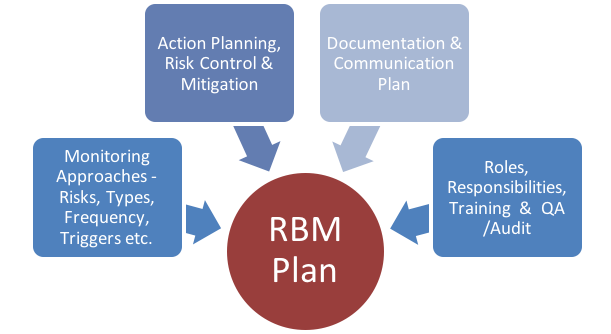
Figure 1 : Various aspects of a Risk Based Monitoring plan
As shown in the Figure 1, there are various pieces of a RBM plan that will be addressed when developing an effective RBM plan. However, with respect to the scope of this article, it is written to cover only the following key facets of RBM plan. An attempt is made to keep it simple and at the same time to provide high-level idea of various aspects of these points below to be considered while developing RBM plan.
· Risks to be monitored. Types of risks and monitoring activities to be used
· Criteria for determining the extent and frequency of different monitoring activities
· Events / Incidences that should trigger changes in planned monitoring activities
Risks to be monitored
First, is the selection of right risks for a given study as RBM plan needs to emphasize the risks to be monitored. The number and type of risks to be monitored will vary study to study and depend on complexity of the study, type of sites, experience of sites, type of patient population, geographies involved, and safety aspects of study drug/device etc. There may be 10 to 20 or more key risks that one wants to monitor for a study. Based on systematic risk identification and assessment carried out after protocol finalization and site selections, these key risks to be monitored for a study would be finalized. These risks would be related to processes, people, systems, and technology involved in the study. Based on the assessment, these risks would be categorized as high/critical, medium or low risks. This categorization of risks will influence some of the monitoring aspects, especially extent of onsite monitoring.
As far as different types of risks are concerned, there are site performance risks, commonly known as KRIs to assess the site performance and site characteristics. The others are data quality risks to identify issues in data quality which are commonly detected using CSM (central statistical monitoring) techniques. Data quality risks are vague and otherwise unpredictable which can occur to any site or any patient data, even if site is showing better performance on other aspects like good patient recruitment rate or CRF completion or query resolution rate. It is advisable to have a right mix of KRIs and CSM reports and to ensure adequate monitoring of a study and thereby effective implementation of RBM.
Table 1: Examples of different types key risks to be monitored & categorization
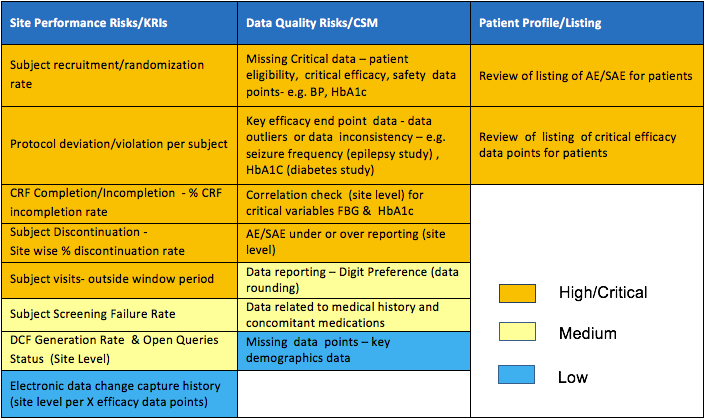
Table 1 shows few examples of risks-KRIs and CSMs which are categorized into-high/critical, medium, and low risks. This categorization of risks will vary study to study depending on what aspects of the study are critical in operational perspective and for data integrity and validity. Based on the study requirements, these risks can be categorized high, medium or low risks. For example, patient recruitment rate is high risk for a difficult to recruit kind of a study if recruitment timeline is a critical factor for the study. At the same time, comparatively easy to recruit kind of study, it may not be high risk but a medium risk and need to monitor for the sites which are recruiting much higher than expected patient recruitment rate, to look at the quality aspects of the data coming in. Similarly, for data quality risks, one would like to monitor CSM reports related to critical data points like A1C or FBG for a diabetes study and for any epilepsy study it may be monthly seizure frequency as key efficacy point. The last column is patient profile where based on risks that are selected in the beginning, the review of the listing of any critical efficacy or safety data points of the patients can be carried out. Thus, a good RBM plan needs to depict all key risks to be monitored for a given study.
As a part of RBM process, monitoring these risks will be done through these three types of monitoring activities and RBM plan should describe how these different monitoring activities would be used. The objectives of using these three monitoring activities are as shown in the Table 2.
Table 2: Objectives of three different types of monitoring
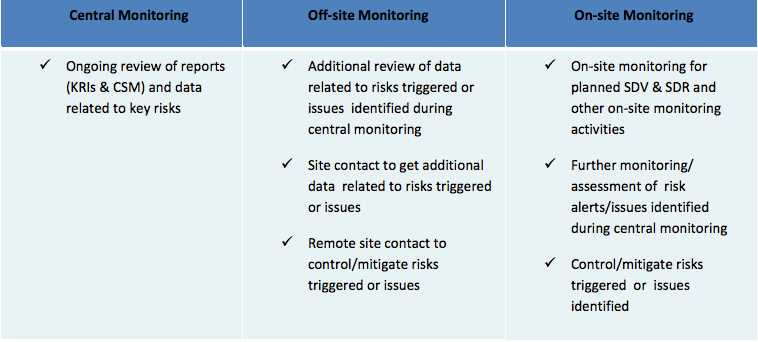
So, after identification and finalization of key risks to be monitored for a study, it is advisable to describe in the RBM plan how to present or visualize these risks in order to monitor them easily through central monitoring. This includes what reports are needed to plan to get correct insights into what is happening on the study. At the same time, proper thresholds at appropriate levels need to be built to enable study teams to take a proactive measures before risks become major problems.
Table 3 shows some examples of type of KRI or CSM reports that one can use for central monitoring. For example, one of the risks related to site performance is in terms of % CRF completion rate. One of the reports that would give correct picture would be % completed CRFs and also % incompleted CRFs with aging and the threshold for this would be in line with what is agreed between sponsor/CRO and sites. It may be within 5 day or 7 days of patients’ visits as agreed. However, this risk is very important to be monitored as around 70%-80% of data that is used to get the risk reports for central monitoring comes from eCRF/EDC. Therefore, it is important for sites to complete the CRFs within a short period of time after patients’ visits as agreed with their sponsors/CROs.
Also, it is necessary to use proper analytics and visualization technology to get these risks reports to the appropriate study team members. In that regard, selection of right technology is very critical for implementation of RBM.
Table 3: Representation of risks reports for central monitoring (some examples)
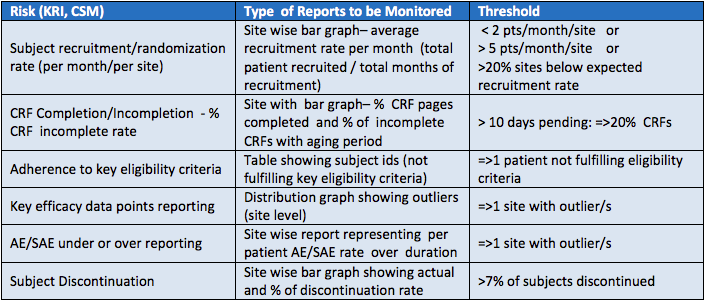
Extent and frequency of monitoring activities
The RBM plan should also define the extent and frequency for monitoring activities for these risks centrally, on-site and off-site.
As far as extent and frequency of centralized monitoring is concerned, it is advisable to carry out 100%, ongoing review of the KRIs and CSMs reports that we planned whether they are high, medium or low risks. Central monitoring serves as a foundation for RBM and it helps identify any risks/issues that might trigger during study conduct. As far as frequency of central monitoring is concerned, it is ongoing and it may be daily, weekly, biweekly or monthly basis depending on the various factors such as-
· Number and types of risks--number of KRIs, CSM reports to be monitored
· Number of patients and sites involved in a study
· Patient recruitment & data generation rate
· Type of study-if it is development study (ie., Phase II, Phase III) or any post marketing study
Off-site monitoring is used for remote site contact to get additional information if needed related to risks triggered or issues seen during central monitoring. It is also for remote site contact to control/mitigate risks triggered or issues identified. Therefore, the extent and frequency of off-site monitoring will depend on the number and types of risks/issues triggered during central monitoring.
Whereas the extent of on-site monitoring is based on your categorization of risks-high, medium, and low. TransCelerate Biopharma in its position paper on RBM has given guidelines on extent of SDV and SDR. As presented in Table 4 below, it recommends higher extent of SDV and SDR for the first randomized patient/subject in all three categorization and where as it suggests lesser extent of SDV or SDR for subsequent randomized patients. Based on the ranges proposed here, the exact extent of SDV and SDR will vary study to study based on criticality of data and various risks involved in a study.
Table 4: On-site monitoring – extent of SDV & SDR

Based on extent of SDV and SDR that we decide for the key risks identified in the beginning and considering other routine activities need to be performed at sites (for example-checking of site files, drug accountability etc), one would decide on-site monitoring visits schedule and frequency. Again, the schedule and frequency of on-site visits depend on expected patient recruitment rate, rate of data generation, and also type/phase of study etc. This schedule and frequency might change to lower or higher side for some sites depending on the sites’ performance and risks/issues detected during central monitoring.
Triggers in planned monitoring activities
The RBM plan should also consider the potentials events/incidences which might lead to changes in the monitoring activities. Some findings/events from KRIs, CSM reports during central monitoring would lead to change in the planned monitoring activities. It is advisable to define in the RBM plan in the beginning regarding these potential events that may lead to change in monitoring plan, especially change in on-site monitoring activities. Table 5 below illustrates such possible events/incidences in different areas based on the risks selected in the beginning of a study.
Table 5: Potential events leading to change in planned on-site monitoring
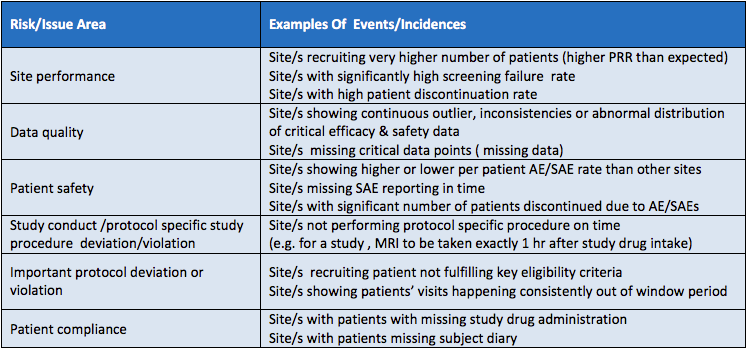
As shown in the Table 5, in site performance area, the sites showing significantly higher than expected recruitment rate or the sites with very high patient dropped out rate might need additional on-site monitoring visits. Similarly, in quality area, the sites showing continuous outliers or with inconsistencies in critical efficacy or safety data might need close monitoring or more on-site visits to see what exactly happening at the sites. The KRIs & CSM reports findings will direct us to specific sites and patients which need close and additional monitoring.
Depending on such events, the on-site monitoring plan might change than originally planned. It may be single or combination of two or more events which will lead to the change to on-site monitoring schedule and frequency. So, during the study conduct, the on-site monitoring plan would look like as shown the table 6 below where green squares indicate planned monitoring visits in the beginning and red squares indicate the shifting of on-site monitoring visits and additional monitoring visits.
Table 6 : Change in on-site Monitoring visits schedule & frequency
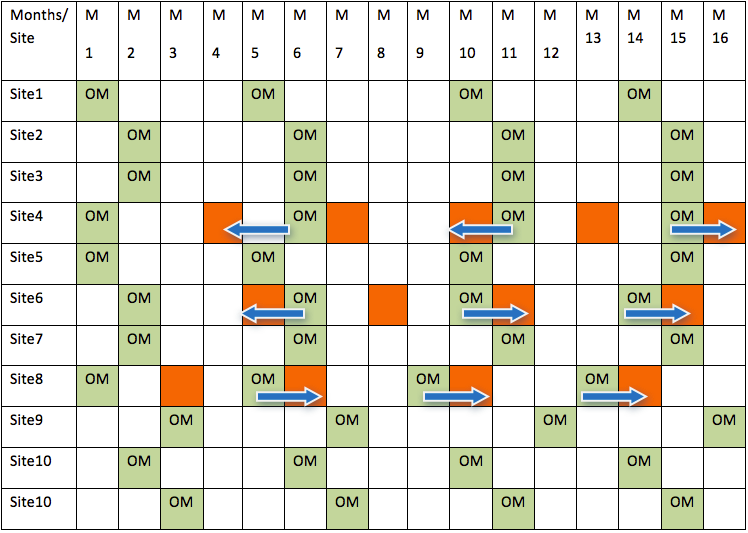
Developing an effective RBM plan is very crucial to successful implementation of RBM and to achieve real benefits of RBM. Identifying right types and optimal number of risks which will allow adequate monitoring of overall study and using good mix of KRIs and CSM reports is very important. RBM plan needs to clearly define the objectives of various monitoring activities, extent, and frequency to monitor those risks. RBM plan should also consider upfront, the potential events/incidences which might change the monitoring activities at sites level. A well developed RBM plan helps in seamless study management, ensures high quality data, better monitoring of patient safety, and brings cost efficiencies as well.
References:
1. https://www.fda.gov/downloads/Drugs/Guidances/UCM269919.pdf
2. http://www.ema.europa.eu/docs/en_GB/document_library/Scientific_guideline/2013/11/WC500155491.pdf

Ashok Ghone, Ph.D. is Vice-President, Global Services at MakroCare USA and Editorial Advisory Board member for Applied Clinical Trials. ashok.ghone@makrocare.com
Improving Relationships and Diversifying the Site Selection Process
April 17th 2025In this episode of the Applied Clinical Trials Podcast, Liz Beatty, co-founder and chief strategy officer, Inato, discusses a number of topics around site engagement including community-based sites, the role of technology in improving site/sponsor relationships, how increased operational costs are impacting the industry, and more.
Behind the Buzz: Why Clinical Research Leaders Flock to SCOPE Summit
February 7th 2025In this episode, we meet with Micah Lieberman, Executive Conference Director for SCOPE Summit (Summit for Clinical Ops Executives) at Cambridge Innovation Institute. We will dive deep into the critical role of collaboration within the clinical research ecosystem. How do we bring together diverse stakeholders—sponsors, CROs, clinical trial tech innovators, suppliers, patients, sites, advocacy organizations, investors, and non-profits—to share best practices in trial design, program planning, innovation, and clinical operations? We’ll explore why it’s vital for thought leaders to step beyond their own organizations and learn from others, exchanging ideas that drive advancements in clinical research. Additionally, we’ll discuss the pivotal role of scientific conferences like SCOPE Summit in fostering these essential connections and collaborations, helping shape the future of clinical trials. Join us as we uncover how collective wisdom and cross-industry partnerships are transforming the landscape of clinical research.